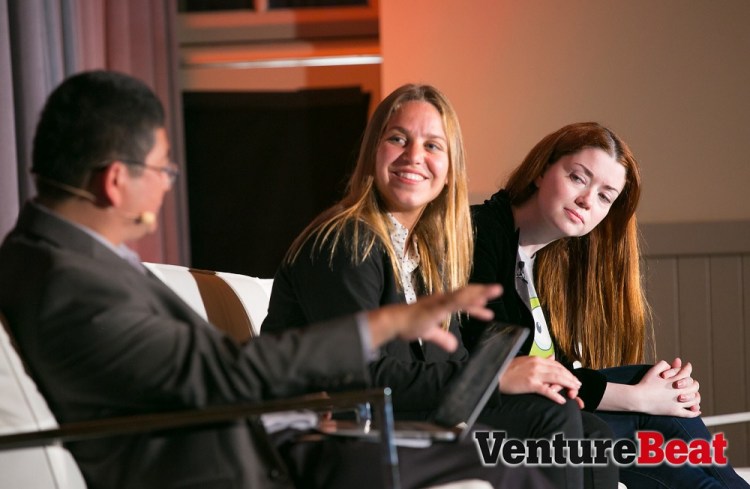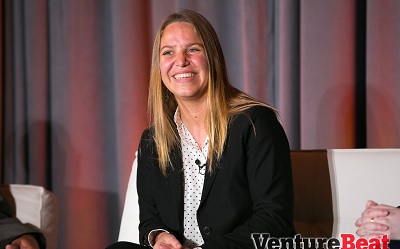SAUSALITO, Calif. — Games used to be a backwater. They were viewed as being too violent. They appealed to boys. They were addictive. They were for nerds. But now everyone wants to learn from them because it has become one of the hottest sectors on the hot platforms of social, mobile, and online content.
The switch from backwater to blockbuster has happened as the mobile audience for games has skyrocketed. Games account for a third of mobile usage. Accidental or intentional, the biggest game companies now include platform makers like Apple, Google, and Amazon. As far as game platforms go, it’s not just Sony, Microsoft, and Nintendo anymore.
At VentureBeat’s Mobile Summit, we interviewed two game experts about the lessons that games can teach other industries. Our speakers included Maria Alegre, the cofounder and CEO of the monetization platform Chartboost; and Diana Moldavsky, chief revenue officer at Cut the Rope-maker Zeptolab. Here’s an edited transcript of our conversation.
GamesBeat: We’re going to talk about what works well with games. Please introduce yourselves. And as an opening question for both of you, what are the lessons that come from games that everyone else should learn?
Maria Alegre: My name is Maria Alegre. I’m the cofounder and CEO of Chartboost. My background is in making games. I was part of the early team that became Disney Mobile. At Chartboost, we’re building the biggest games-only business engine.
What we mean by that is we’re building technology that helps game developers build a business behind their creations. Right now we work with 60,000 game developers. At any given point, we’re working with more than 70 percent of the top iOS and Android games. We’re three years old, based in San Francisco.
Diana Moldavsky: Zeptolab is the company behind Cut the Rope. We’ve been around just a bit more than three years. To date, we have more than half a billion downloads and more than 60 million monthly active users playing our games.
Alegre: So, what can nongaming business learn from games? I could give you a big list, but I’ll focus on one thing, which is both the challenge and opportunity of interacting with users many times during the day. They always have their phone with them, and you’re interacting with them in these one-minute-long sessions. Games have been the first to figure this out.
Games have had to master the transition from console gaming to web and then to mobile. On console, you had one-hour-long sessions or longer. Web is in the middle. Mobile, at the other extreme, has 1 minute play sessions. What [developers] have done is change their formula, creating games that work in a shorter session, and they’ve mastered instant gratification – focusing on one game mechanic at a time and delivering fun in a short amount of time. Then they give you a good reason to come back.
Any nongame business that figures those things out — change the formula, deliver instant gratification, and give a good reason for the user to come back to the app — can be successful building a business in mobile.
Moldavsky: One thing to consider [is that] many companies start with brands. Their goal is creating brand awareness and an engagement with their story. As a gaming company, we do all that as well. We can work together with other brands, because we’re a brand ourselves. Cut the Rope and the character it’s built around – this green monster Om Nom – have become a recognizable brand. We can help other brands reach this huge audience that we’ve discovered on mobile.
It’s not necessarily just about advertising, although we’ve all been doing that. We have new things that we’re ready to do for brands now in our games. We’re looking at more involved integrations and partnerships where — say you’re a fashion brand. Om Nom could wear hats from your brand. If you’re a candy brand, he could be eating something specific instead of the generic candy he’s eating now. Today, in just our ad-supported versions, more than 200 million candies are eaten every month. That could be any brand of candy.
Every year, on holidays, we have a holiday-themed app. We could as easily do a themed version of the app with any brand that makes sense. It’s just a matter of having that exposure and that relevance and targeting an audience.
Alegre: Games have created a big engagement with users. We’re talking about 60 percent or more of users coming back every single day. Games create a big connection with consumers. We see that in the real world in music and celebrities, how music and celebrities are used with brands to promote products. There’s a big opportunity for any product in the world, even if they have nothing to do with a game, to leverage a new form of entertainment in mobile games that have created a deep connection. It’s a new form of partnership.
Moldavsky: Music is a great example. Just like music, games have an emotional connection with the consumer. For our character, Om Nom, people write us letters about how much they like him, how they want to dress up their children as Om Nom for Halloween. Or we have kids writing us letters about how they want us to add their idea for a monster to Cut the Rope 2, sending us pictures and ideas. There’s a deep emotional connection. People want to take care of this monster, to feed him, to have him as a pet. This level of emotion is a big thing.
GamesBeat: You’re starting to get into something that leads to the next question here. Games have something that many apps and brands don’t have, which is hardcore fans. They build their own communities. They get in arguments with each other. How do you make something like that happen outside of games, this passion around the product?



